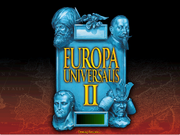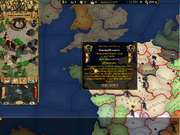
The loading screen
Europa Universalis II (abbreviated to EUII) is the second installment in the Europa Universalis series. Like all the other games in the series, EUII is a complex real time strategy game, covering the period from the late middle ages through to the era of the Napoleonic Wars.
In the game, you play a country over years, decades, or centuries - guiding their decisions. The aim of the game is for your country to gain more victory points than any other country. Victory points can be obtained through a variety of different styles of play. Diplomacy, conquest, colonial expansion, and completing in-game missions are all viable ways to gain points.
The vanilla game comes with a number of different scenarios. The Fantasia campaign (1500-1822) contains just seven countries on an otherwise empty planet. All the other scenarios have a starting point that is modeled on history. They all end on the 1st of January 1820, but have different starting years.
- 1419 (The Grand Campaign)
- 1491 (The Age of Exploration)
- 1617 (The Age of Mercantilism)
- 1700 (The Age of Enlightenment)
- 1773 (The American Dream)
- 1773 (The Age of Revolutions)
- 1795 (Napoleon's Ambition)
The difference between the two 1773 scenarios is that The American Dream can only be played as the USA.
The game can be played in both single player and multi player modes.
Game Interface

In game screen shot
There are a number of different elements to the game interface. Many of them will provide tooltips giving you additional information when you hover over them.
- Game Options from the startup screen
- The Main map takes up most of the screen, and can be changed to show a number of different things. You can zoom in and out using the magnifying glass icons at the bottom of the Info Box.
- The Status Bar, at the top of the screen, shows a number of key bits of information about your country. It also contains the pause button (in the top right corner). When the game is paused, the player can still control everything
- The Information screen at the left of the screen shows information on anything you have just clicked on the map, as well as a number of other menus available via the icons at the top of it.
- The Mini-map shows the whole of the known world. It highlights seiges you are involved in as red dots, but can be changed to show various kinds of unit instead.
- The Missions Scroll will bring up a list of possible missions.
- The Ledger is the book at the bottom right of the info box. Clicking on it brings up a whole range of of graphs and tables about your country and the whole world. Opening the ledger obscures everything else on the screen, so it is often a good idea to pause, or slow the game speed, before opening the ledger.
- Menu (at the bottom of the info box) allows you to change game options, load or save a game, and exit the game (by clicking "Surrender").
- The Game Log is the dark area at the bottom of the screen. It records some of the things that happen in the game. The game options allow you choose what gets recorded here. It can be minimised.
- Pop-ups. When certain things happen, the game will give you a pop-up window, some of which will pause the game. You can control which events cause a pop-up in the game options. Everything that gets a pop-up will also appear in the game log.
Game Concepts
As you would expect from a complex stategy game, there are a number of different game concepts that can take some time to master.
- Countries - each player controls one country, and the AI controls all the others. You can choose any country that exists at the start of your scenario.
- Monarchs are the leaders of your country, and the term is used even if you are a republic. A monarch has a level in three different skills, which affect your country. Generally speaking, monarchs rule for the same period they did in real life.
- Cities and Provinces are the basis of your country. A province is an area in the map. A city is the settlement in that province, and can build buildings that enhance its output, and build troops.
- Warfare - even with a peaceful playstyle, your country will get into the occasional war. A successful game requires that you know how to manage your armies and navies.
- Economy - without money, your country won't be able to do very much, and will probably be conquered. You raise money primarily by production, raising taxes and by trading, and spend it on all sorts of things.
- Diplomacy is essential for all but the most isolated countries.
- Religion has a major effect on gameplay.
- Stability is a measure of how united your country is. If you have very low stability, your peasants will probably revolt, and your country will find almost everything more difficult.
- Domestic Policies are a measure of what kind of society your country is. There are eight different policy sliders, and you can adjust one of them by one point (out of ten) once per decade.
- Technology is how advanced your country is. There are four different types of technology. Researching one to the next level will give your country certain benefits.
- Exploration. At the start of the game (even in a late start), you will not be able to see the entire map. Certain units and technologies will allow you to explore the Terra incognita. There are certain areas of the map (permanent terra incognita) which cannot be explored at all.
- Colonisation is the process of settling lands which are not claimed by an existing country. Many countries will never create a colony, but colonial powers tend to be more powerful than their non-colonial neighbours.
- Events are a key part of gameplay. Random events can happen to any nation which meets the necessary conditions, and provide either a boost or a setback. Scripted events are designed for a specific nation, and replicate real historial events (or, sometimes, something akin to them), or sometimes events that would have happened if history had better resembled your game. Finally, there are a handful of global events that affect every country.
Expansions and Mods
There was one offical expansion of EUII, Europa Universalis II: Asia Chapters. This was less an expansion, than a retooling for the Asian market. It added a number of graphics, and provinces in Japan, Korea, and China. Its scenarios were much more asian-focused than those in the original.
Perhaps the most notable mod is AGCEEP, a mod that introduces a number of new nations and a lot of new events. In AGCEEP, the AI countries act much more like their historical selves, and there are a lot of events that simulate what would most likely have happened if your game takes history off on a different course AGCEEP was the basis for the fan-made, standalone release For The Glory in 2009.
